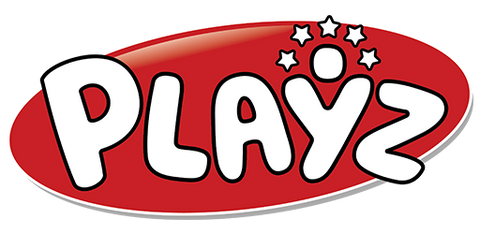
Best Robotics Kits for Beginners to Start Building Today
Think of a beginner robotics kit as the ultimate all-in-one toolbox for diving into engineering, coding, and creative problem-solving. It's like a LEGO set that grew a brain—you get every single piece you need to build, program, and watch a real robot come to life. These kits are the perfect starting line for anyone curious about how modern technology really works.
Why Start Your Journey with a Robotics Kit?
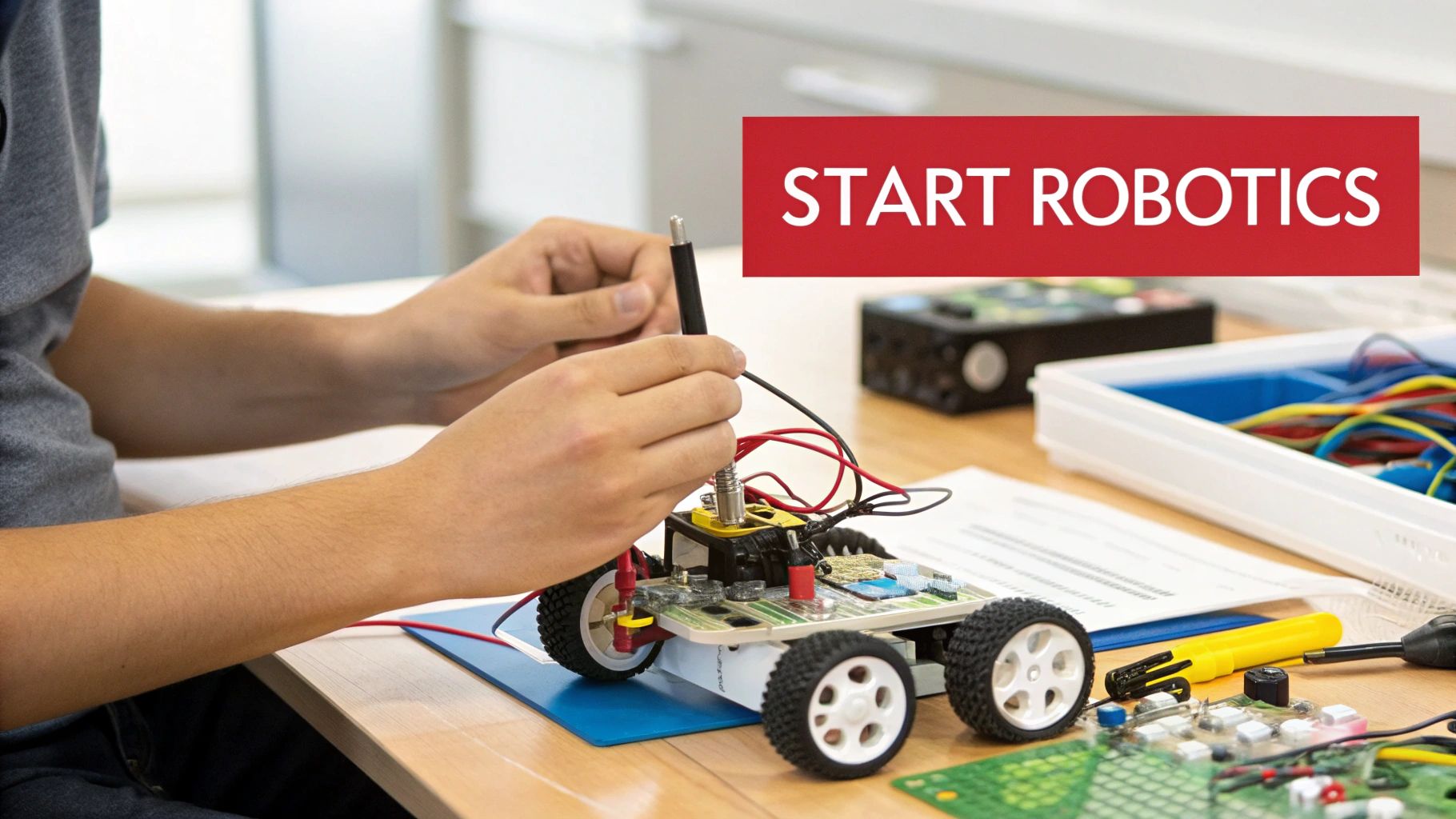
Ever watch a sci-fi movie and wonder, "Could I actually build something like that?" The answer is a resounding yes, and it’s more achievable than you might think. Robotics isn't just for high-tech labs anymore; it's something you can explore right from your living room floor, all thanks to the boom in robotics kits for beginners.
These kits are brilliant because they take complex ideas and break them down into fun, manageable steps. Instead of just reading about circuits or staring at lines of code, you're physically connecting wires, writing simple commands, and seeing your creation actually move. It’s an incredible "Aha!" moment when an abstract concept suddenly becomes a real, whirring machine you built with your own hands.
More Than Just a Toy: Real-World Skill Building
Don't get me wrong, these kits are a ton of fun, but they're also serious educational tools in disguise. They’re designed to help cultivate skills that are valuable no matter what field you end up in. The hands-on process of building and programming a robot naturally rewires how you approach challenges.
You start to tackle problems with a more logical mindset, breaking big, overwhelming goals into smaller, actionable pieces. This hands-on approach is a huge reason why STEM toys for kids are so effective—it transforms learning into genuine, engaging play.
Key Takeaway: A robotics kit does more than teach you to build a machine; it teaches you how to think like an engineer, a programmer, and a problem-solver all at once. It’s an investment in future-ready skills, not just a toy.
A Clear Path for Every Learner, from Novice to Pro
One of the best things about modern robotics kits for beginners is how they adapt to different skill levels. Whether you're a complete novice or have tinkered a bit before, there’s a clear path forward from your first simple build to becoming a confident creator.
Here's what makes them so great for learning:
- Structured Learning: Kits come with step-by-step guides that walk you through your first project, so you can build confidence right from the start without any guesswork.
- Creative Freedom: Once you master the basics, the real fun begins. You can start experimenting, tweaking designs, and even inventing your own unique robots from scratch.
- Future-Ready Skills: The abilities you pick up—from coding logic to understanding mechanics—are directly applicable to future classes, hobbies, and even careers in technology.
This guide will walk you through everything you need to know, from picking the perfect kit to ensuring your very first project is a smashing success.
How Robotics Builds Essential Skills for the Future
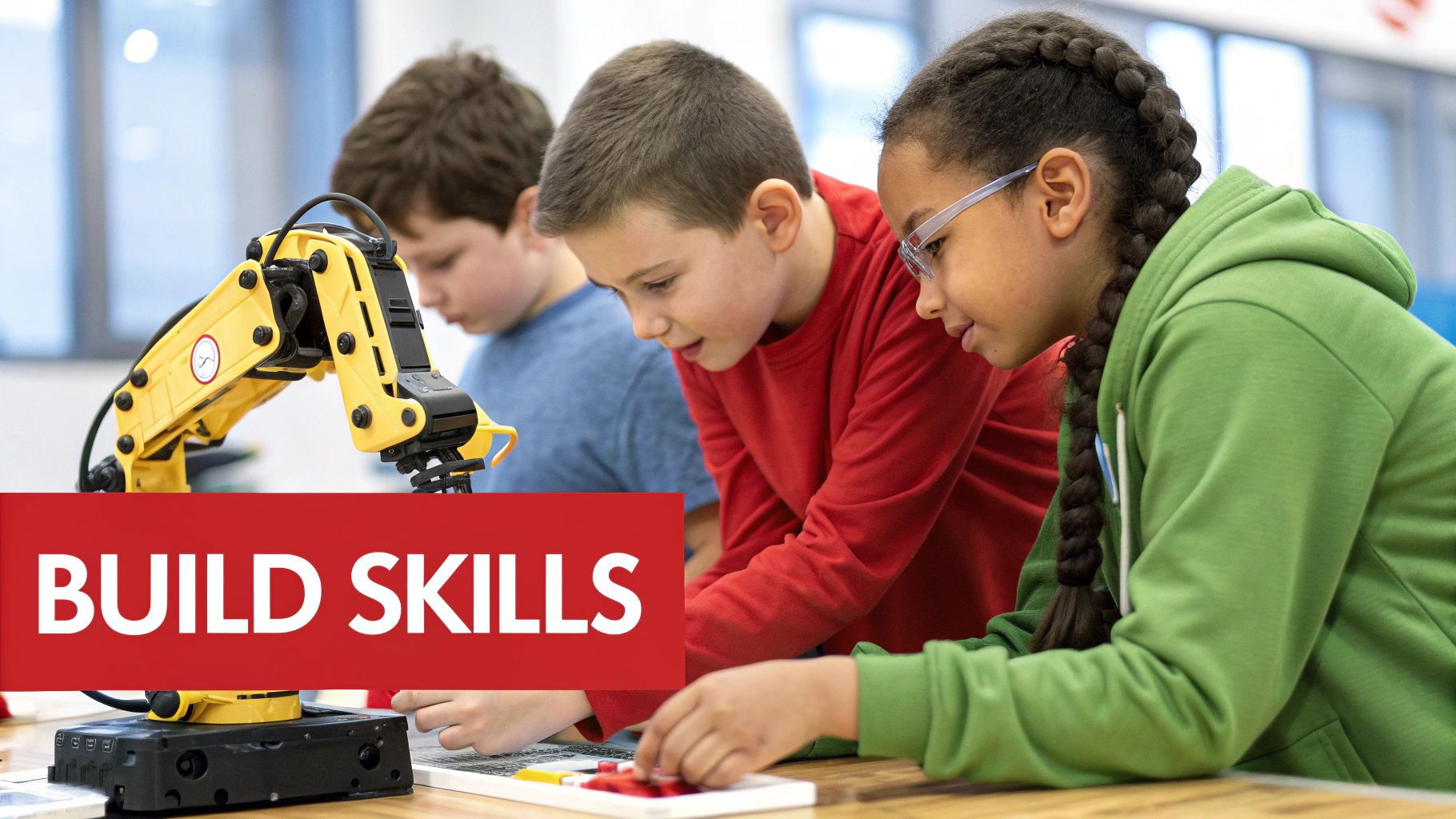
Working with a robotics kit is so much more than building a cool gadget. It’s a hands-on masterclass in the exact skills kids will need for a future where tech is at the heart of everything. Each step, from snapping pieces together to programming a robot’s first move, builds a powerful foundation for a lifetime of learning and innovation.
Think of it this way: every time a project hits a snag—a wheel won’t turn or a sensor misreads—it’s a puzzle, not a dead end. Solving these little challenges is how kids strengthen critical thinking and resilience. They learn to approach problems calmly and analytically, a valuable trait in any field.
Making Coding Tangible and Fun
Learning to code with a robot is completely different from just staring at a screen. Instead of abstract lines of code, every command creates a real, physical result. For example, typing a command to "turn motor A" makes a wheel spin right in front of you. That immediate feedback makes tricky concepts like loops, variables, and if/then logic feel tangible and intuitive.
It’s like learning a new language by actually visiting the country where it’s spoken. You don't just memorize words; you learn how to use them to navigate and interact. Similarly, programming a robot to follow a line on the floor turns coding into a practical tool, not just an academic exercise. This is why robotics kits for beginners are so effective at sparking a genuine interest in computer science.
Actionable Insight: Robotics transforms coding from a purely digital activity into a physical one. It connects the world of software to the world of hardware, demonstrating that code can make things happen in the real world. This connection is key to deeper understanding.
The global educational robot market shows just how big this idea has become. Valued at roughly USD 1.4 billion in 2022, it’s projected to hit USD 3.2 billion by 2027. This rapid growth signals a massive shift toward interactive tools that make learning something you can touch, see, and control.
Developing a Problem-Solving Mindset
The real magic of robotics lies in how it teaches systematic problem-solving. Assembling the robot requires following instructions, paying close attention to detail, and understanding how mechanical parts fit together. It’s a crash course in spatial reasoning and engineering fundamentals.
Once built, the next challenge is programming its behavior. This forces kids to break a big goal into smaller, manageable steps. For example, to make a robot pick up a block, you must program it to:
- Move toward the block.
- Stop at the correct distance using a sensor.
- Lower its arm.
- Close its gripper.
- Lift the arm back up.
This step-by-step process is the heart of computational thinking, a skill that applies to nearly every part of life. To learn more about this, check out our guide on how to develop problem-solving skills.
Paving the Way for Future Opportunities
The skills learned from robotics kits for beginners aren't just for fun—they’re direct preparation for future careers. The world needs more people who can think critically, innovate, and work alongside automated systems.
By building and programming robots, kids get a head start in fields like:
- Engineering: Understanding mechanical design, electronics, and how complex systems work together.
- Computer Science: Gaining hands-on experience with programming, algorithms, and even artificial intelligence.
- Creative Technology: Blending technical skills with artistic vision to create interactive art or smart home devices.
Ultimately, a simple robotics project can be the spark that ignites a lifelong passion for STEM, building confidence and proving that anyone can be a creator, an inventor, and a problem-solver.
Understanding the Key Components of a Robotics Kit
Opening a robotics kit for the first time can feel a bit overwhelming—like staring at a pile of mysterious parts. But once you realize that every robot, no matter how simple or complex, is built around three core elements, it all starts to click.
Think of it this way: a robot is essentially a machine that can sense its environment, think about what to do, and then act. Those three functions line up perfectly with the main hardware components you'll find in any beginner's kit. Understanding these pieces is the key to knowing exactly what you're buying and how it all works together.
The Brain, The Senses, and The Muscles of a Robot
At its heart, every robot works by taking in information, processing it, and then doing something in the real world. This simple concept—Sense, Think, Act—is the foundation of all robotics.
This infographic breaks down that relationship perfectly.
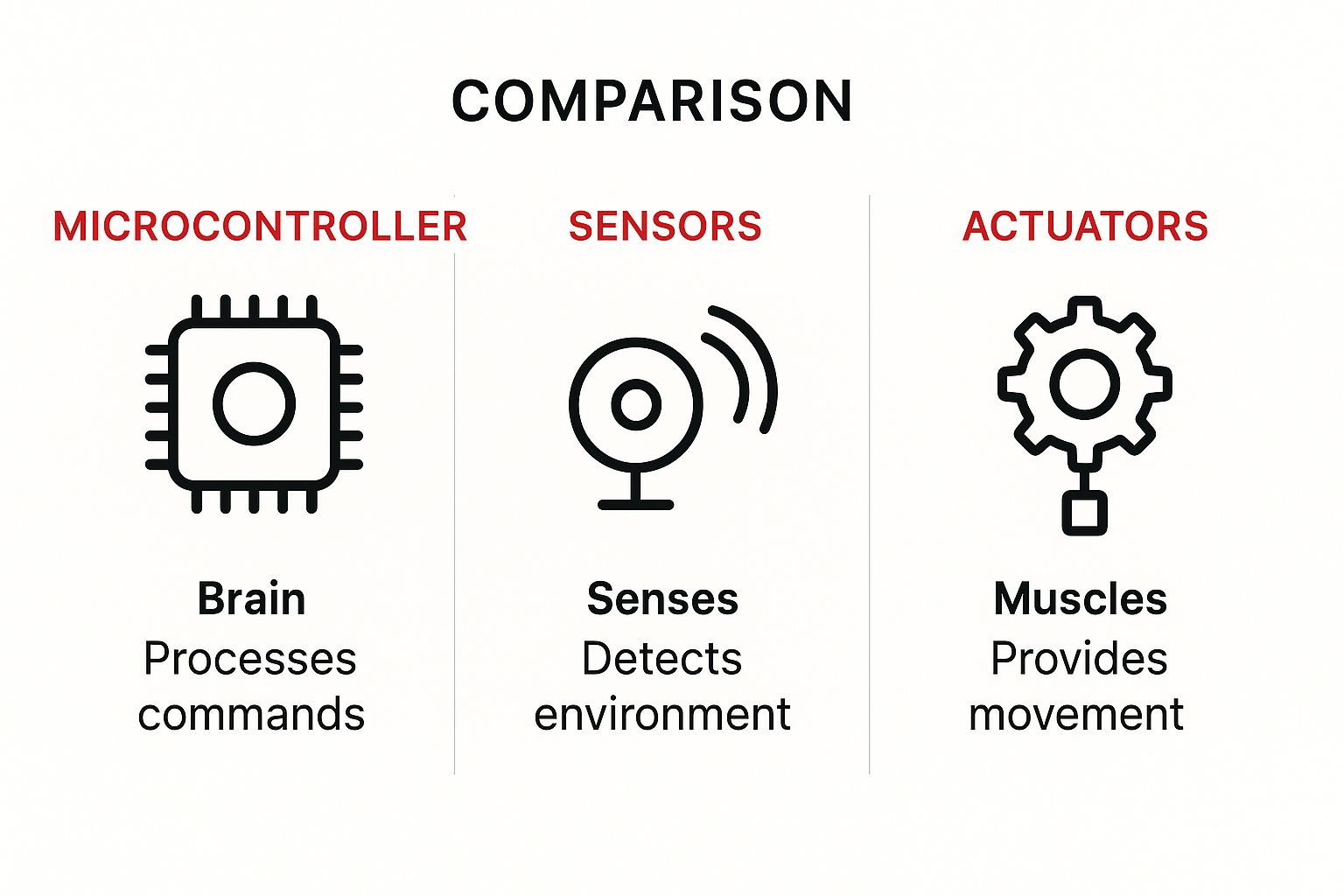
You can see how each part has a distinct job, but they all must work together seamlessly to bring the robot to life. Let's dig into what each of these components actually does.
Essential Features in Beginner Robotics Kits
When you're comparing different kits, you'll see a lot of technical terms. The table below breaks down the essential features into plain English, explaining what each part does and why it's so important for someone just starting out.
| Feature | What It Is (The Robot's...) | Why It's Important for Beginners |
|---|---|---|
| Microcontroller | The Brain | This is a tiny, programmable computer (like an Arduino) that runs your code. It’s the command center that makes all the decisions for the robot. |
| Sensors | The Senses | These parts collect information from the outside world. Think of ultrasonic sensors for measuring distance or touch sensors for detecting bumps. |
| Actuators | The Muscles | These are the parts that create movement or action. This includes motors for wheels, servos for arms, and even components like LEDs and speakers. |
| Programming Interface | The Language | This is how you tell the robot what to do. The best kits start with simple drag-and-drop block coding before moving to text-based languages. |
| Power Source | The Energy | A battery pack or USB connection gives the robot the power it needs to operate its brain, senses, and muscles. |
| Building System | The Skeleton | These are the physical pieces—beams, gears, and connectors—that you use to build the robot's body. A good system is sturdy and easy to assemble. |
Understanding these six elements will empower you to look past the marketing hype and choose a kit with the right capabilities for your child's learning journey.
How a Robot Learns to "Speak": An Intro to Coding
Once the hardware is assembled, you need a way to communicate with it. That's where programming comes in, and thankfully, the best robotics kits for beginners make this incredibly accessible.
Most starter kits use visual block-based coding, like Scratch. Instead of typing complex commands, kids drag and drop colorful blocks that represent actions like "move forward 10 steps" or "if an object is detected, turn left." It's an intuitive and fun way to learn programming logic without the frustration of typos.
Actionable Insight: Visual block coding removes the intimidating wall of text and turns programming into a puzzle. It focuses on the 'what' and 'why' of coding, not just the syntax, making it perfect for first-timers.
What’s really great is that many of these kits grow with your child. Once they’ve mastered block coding, they can often switch to text-based languages like Python or C++ using the very same hardware. This scalability is a huge plus, as it means the kit remains challenging and useful for years.
From Simple Circuits to Smart Robots
The demand for these hands-on learning tools is exploding. The global market for robotics kits was valued at around USD 5.4 billion in 2023 and is expected to more than double to USD 11.2 billion by 2032, according to research by Dataintelo. This isn't just a fad; it's a reflection of how valuable hands-on STEM education has become.
Knowing the core components helps you see how everything connects—from the simplest circuit to a fully functional robot. For instance, learning how a switch closes a circuit to light up an LED is the exact same principle that allows a sensor to trigger a motor. Starting with kits that teach these fundamentals, like an electrical circuit board engineering kit, builds a solid foundation that makes tackling more advanced robotics projects much easier down the road.
How to Choose the Right Robotics Kit for Your Goals
So, you know what’s inside a typical robotics kit. Now comes the critical part: picking the right one. This isn't about finding the box with the most gears or sensors. It’s about matching the kit to the person who will use it—their age, current skill level, and personal interests. A kit that’s a perfect fit for a curious 8-year-old could feel too simplistic for a teen eager to dive into coding.
To find that perfect match, you just need to ask a few key questions. Think of it as a checklist to help you narrow down the options and pick a kit that will be engaging, appropriately challenging, and—most importantly—a lot of fun.
Asking the Right Questions Before You Buy
Before you start browsing brands, take a moment to define what success looks like. The answers to these questions will create a clear profile of the ideal kit for your aspiring builder.
-
Who is this kit for? Age is the most important factor. A kit for a young child (ages 5-8) should have large, durable parts and icon-based or screen-free coding. For a teenager, you’ll want something that introduces complex mechanics and real, text-based programming.
-
What’s their current experience level? Be realistic. Are they a total beginner who has never built anything more complicated than a pillow fort? Or have they mastered complex LEGO sets and experimented with block coding? Getting the skill level wrong is the quickest way to turn fun into frustration.
-
What do you want them to learn? Is the primary goal to understand mechanical engineering, or is it to get an introduction to Python? Some kits are built for pure engineering, while others focus heavily on electronics or coding. Pinpointing a primary goal helps you focus on the right products.
-
What’s your budget? Robotics kits have a wide price range. Setting a budget helps you filter out the noise and focus on options that provide the best value. Remember, a higher price doesn’t always mean a better learning experience for a beginner.
Comparing Different Types of Robotics Kits for Beginners
With your answers in hand, you can start exploring the different kinds of robotics kits for beginners. Each category offers a unique path into the world of robotics, tailored for different ages and interests.
- Snap-Together Electronic Kits: These kits focus on the absolute basics of circuits. They often use magnetic or snap-on pieces, making it easy for younger kids to build things like a simple alarm or a light-up car without needing to handle small wires.
- Programmable Vehicle Kits: This is one of the most popular categories. You build a robot on wheels—like a car or a tank—and use block-based or text-based code to program its movements and reactions to sensors. They’re fantastic for learning the fundamentals of navigation and control.
- Modular Building Systems: Think of these as the next evolution of classic building blocks. They come with a huge assortment of beams, gears, motors, and sensors that you can combine in endless ways, encouraging open-ended problem-solving.
- Humanoid and Animal-Like Kits: These are a step up in complexity. You can build robots that walk, dance, or mimic animal movements. They often require more patience but offer a huge payoff in understanding biomechanics and advanced robotics. For a closer look at kits that focus on structural builds, check out these engineering-focused building kits.
Pros and Cons of Common Kit Types
To help you sort through the options, this comparison table breaks down the most common types of beginner robotics kits. It’s a quick way to see how each category lines up with different ages and learning goals.
| Kit Type | Ideal Age Range | Primary Learning Focus | Pros | Cons |
|---|---|---|---|---|
| Snap-Together Kits | 5-8 years old | Basic circuits & electronics | Very easy to use, instant results, safe for young kids | Limited complexity, quickly outgrown |
| Programmable Vehicles | 8-13 years old | Coding, sensors & navigation | Great balance of building and programming, highly engaging | Designs are often limited to wheeled vehicles |
| Modular Systems | 10+ years old | Engineering, design & creative coding | Highly versatile, endless creative possibilities, grows with skill | Can be overwhelming, steeper learning curve |
| Humanoid/Animal Kits | 12+ years old | Advanced mechanics & motion | Visually impressive, teaches complex movements | Often more expensive, intricate and challenging assembly |
Ultimately, finding the right kit is less about specs and more about the experience it creates.
Key Takeaway: The best kit isn't the most advanced one—it's the one that creates a positive and empowering first experience. Choose a kit that aligns with the learner's current abilities while offering a clear path to grow their skills. This approach builds confidence and sparks a lasting interest in technology.
Bringing Your First Robot to Life: A Beginner's Guide
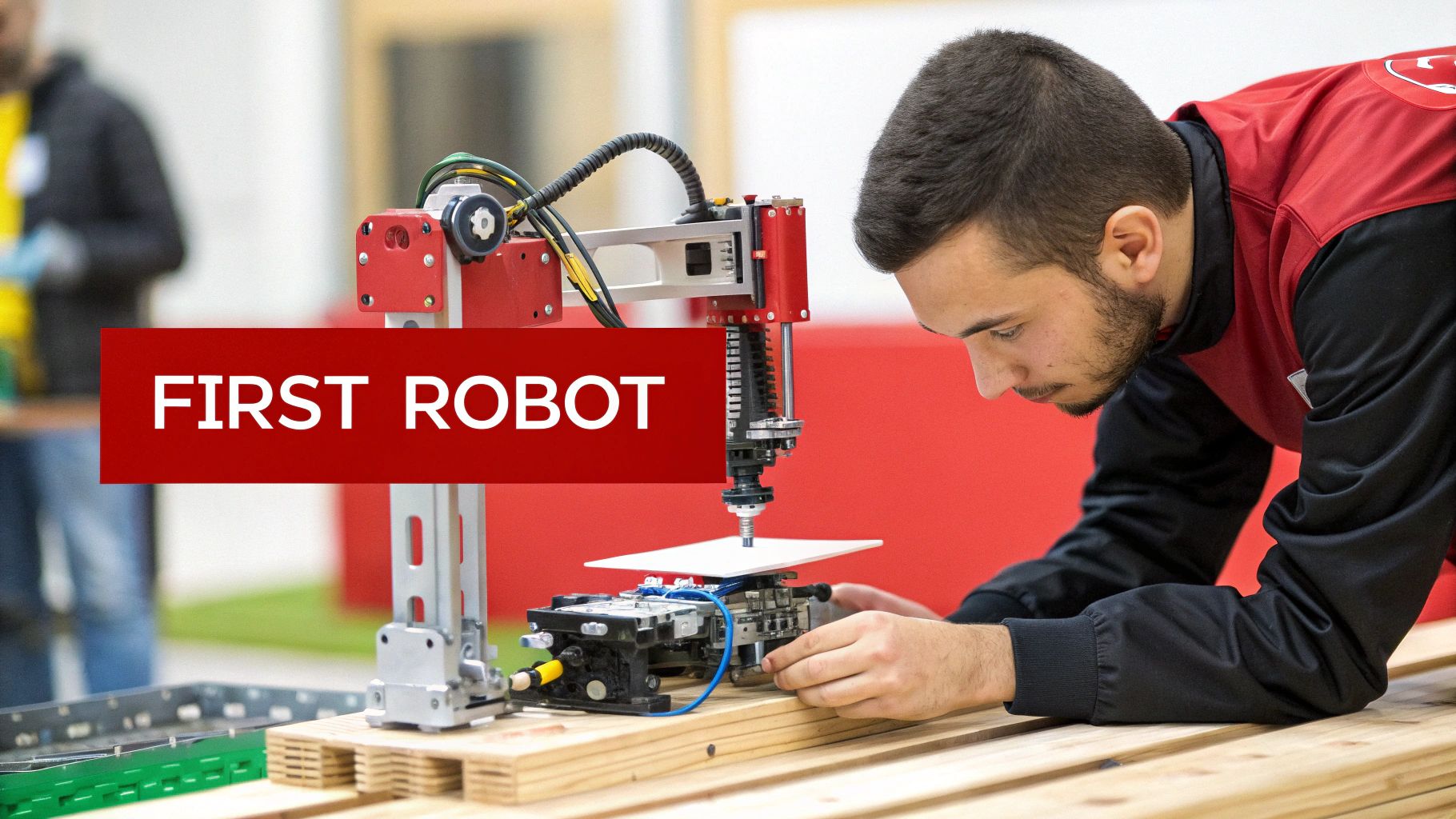
The box has arrived, and the excitement is high. That moment you open your first robotics kit is where the real journey begins. To maintain that positive energy, it helps to have a plan instead of just diving headfirst into a pile of parts. A little preparation now saves a lot of frustration later.
Start by finding a clear, well-lit workspace. Lay out all the components and check them against the parts list in the manual. This quick inventory ensures nothing is missing and helps you get familiar with the names of different sensors, motors, and connectors before you even start building.
Setting Up for Success: Your First Build
Think of your workspace as your personal mission control. A clean, organized area is crucial for a smooth build. Use small containers or a divided tray to sort screws, bolts, and other tiny pieces. This simple step can prevent a critical part from rolling off the table and disappearing forever.
With everything sorted, your first mission is to get a quick win. Don't try to build the most complicated robot possible right away. Instead, follow the step-by-step instructions for the kit’s introductory project. These guided builds are designed to teach you the fundamentals and build your confidence.
Actionable Insight: Your first project is less about the final robot and more about learning the process. Follow the instructions carefully, pay attention to how parts connect, and savor that first moment your creation whirs to life. That initial success is a massive motivator.
While these kits make robotics feel like play, the skills you’re building have serious real-world applications. The industrial robotics market is projected to hit around USD 15 billion in 2025, and innovations in that sector often trickle down into educational tools, leading to better and more affordable learning systems.
From Guided Build to Creative Explorer
Once you've successfully completed the first project, the real fun begins. Now it's time to experiment. Think of the included parts not as a single-purpose set, but as a toolbox for your imagination.
Start small by modifying the robot you just built. Can you make its arm move faster by changing the code? What happens if you add another sensor?
Once you feel comfortable making tweaks, you can tackle bigger challenges. The key is to keep learning fun by setting small, achievable goals. Here are a few real-world examples to get you started:
- Build a Simple Maze: Use books or cardboard to create a small maze and program your robot to navigate from start to finish.
- Program a Light Response: Use a light sensor to make your bot follow a flashlight beam or stop when it enters a shadow.
- Design a Sound-Activated Bot: Program your robot to start moving or flash its lights when you clap your hands.
- Create a Basic Sweeper: Try attaching a small brush to your robot. Can you program it to clean a small area, just like a real-life robotic vacuum model kit?
Learning from Mistakes Is Part of the Fun
Here’s a critical piece of advice: things will go wrong. Your robot will turn left when you told it to go right, a wire will pop loose, or your code will have a bug. This isn't failure; it's troubleshooting.
Honestly, troubleshooting is one of the most valuable skills you'll learn from robotics. Every mistake is just a puzzle waiting to be solved—and an opportunity to understand how everything really works on a much deeper level.
FAQ: Common Questions About Getting Started with Robotics
Jumping into the world of robotics kits is exciting, but it's natural to have a few questions. Getting clarity on these common points is the best way to feel confident as you choose the right kit and kick off your building adventure. Here are answers to the most frequent questions we hear.
Do I Need Any Coding Experience to Start?
Absolutely not! In fact, the best robotics kits for beginners are designed for people with zero coding background. Most start with visual, block-based programming where you drag and drop commands to tell your robot what to do. It’s an incredibly intuitive way to learn programming logic without getting bogged down by complex syntax.
The best part? As your skills grow, many of these kits also support text-based languages like Python. This means the same hardware can evolve with the learner, becoming a valuable tool for years as they level up.
Real-World Example: Think of block coding like learning the rules of the road—stop signs, traffic lights, and right-of-way. Text-based coding is like learning to drive a manual car. Both get you where you're going, but one gives you much more control once you're ready for it.
What Is a Good Age to Introduce a Child to Robotics?
You can start as early as age 5 or 6. Kits for this age group typically feature large, snap-together parts and simple, icon-based coding that’s perfect for little hands and developing minds. Once kids hit the 8-12 range, the kits introduce more complex mechanical principles and advanced block coding.
For teens and adults, the options are nearly limitless. You can jump right into advanced kits that explore sophisticated electronics, complex sensors, and text-based programming. The key is to match the kit's complexity to the user's age and comfort level to keep the experience fun and rewarding, not frustrating.
Are Robotics Kits Expensive?
Not necessarily. While prices can range from under $50 for a simple kit to several hundred for an advanced one, the market is now packed with affordable, high-quality options.
You can find many excellent, feature-rich robotics kits for beginners in the $100 to $200 range. Our advice: determine your budget first, then look for the kit that packs the most value and learning potential into that price point.
Ready to find a kit that makes learning feel like an adventure? Playz offers a collection of science and engineering kits designed to spark curiosity and help kids build skills that will last a lifetime.
Explore our collection of STEM kits and start your robotics journey today!
